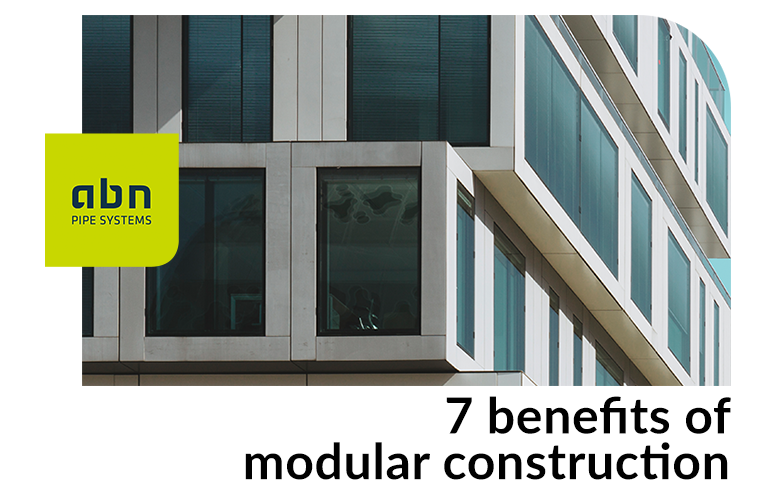In recent years, the construction industry has undergone a radical transformation, evolving to adapt to new social and technological advances, leaving behind traditional construction techniques.
In this new scenario where immediacy, versatility, and sustainability are key attributes in a project, one of the trends that has emerged strongly is modular construction.
What is modular construction?
Modular construction, also known as prefabricated construction, involves manufacturing building components in a location separate from their final construction site and then transporting and installing them at the final location.
These components, or modules, are designed and manufactured under controlled conditions, ensuring high quality and precision in construction.
Modular homes promote flexibility and customization in building projects and provide an alternative to the current situation of mass construction with high costs and long timelines
Structurally, modular buildings are generally more robust than traditional constructions because each module is independently developed to withstand the rigors of transportation and crane operations during installation.
The materials used for modular construction vary. The most common being concrete, wood, and steel. However, there are also modular houses made from other materials such as stone and slate.
Benefits of modular construction
Here are some of the numerous advantages of modular construction:
1. Faster and optimized construction times
Execution times are much shorter compared to traditional construction. According to various studies, on average, you can save 50% in completion times for a prefabricated home compared to conventional construction.
Additionally, since it is constructed in modules, the interior finishing process occurs simultaneously with assembly.
2. Cost savings
Reducing construction times also reduces costs. The average price of these constructions ranges from 800 to 1,000 euros per square meter, while traditional constructions typically range from 1,300 to 1,600 euros per square meter, mainly due to process standardization and large-scale production
Furthermore, the price is usually fixed before purchase, avoiding unforeseen expenses or cost increases.
3. Quality and precision
Factory-based construction allows for rigorous quality control since each module is built under controlled conditions and undergoes strict inspections before being transported to the site.
This quality control extends not only to the final modules but also to each component that makes up a specific piece
This quality control extends not only to the final modules but also to each component that makes up a specific piece.
4. Energy efficiency
These new constructions incorporate the latest innovations and energy efficiency certifications, leading to significant energy savings.
Most modular buildings are made of reinforced concrete, which is an excellent insulator. Some even combine concrete with expanded polystyrene, which also influences the thermal insulation of the houses.
It is precisely this excellent insulation that has a direct impact on the energy savings of the houses. The house will require less use of aerothermal systems and this will be noticeable in the electricity bill and the pollution it produces.
5. Reduced environmental impact
Manufacturing modules in a factory significantly reduces on-site waste production because the pieces sent to the site are nearly finished. Moreover, the factory process allows for better material control, reducing waste and promoting recycling.
Moreover, the factory process allows for better material control, reducing waste and promoting recycling. This approach also reduces water and dust pollution and minimizes noise impact.
6. Adaptability and scalability
Assembled with modules, modular buildings always have the opportunity to expand when needed, allowing for improvements and advancements.
7. Personalization and design flexibility
Modular construction is not limited by traditional construction methods, which means that designs can be more creative and customized according to the client’s needs and budget.
La metodología BIM para la instalación de sistemas de tuberías en construcciones modulares
The BIM Methodology for Pipe Systems Installation in Modular Construction The key advantage of the BIM methodology in prefabricated construction is its ability to facilitate collaboration among multidisciplinary teams. This promotes greater efficiency in decision-making and better control over costs and execution timelines.
When it comes to pipe systems, a key success factor for installation is creating a working methodology, developing the action plan in advance, and following it precisely while ensuring that the modular system remains adaptable.
Developing a prefabricated pipe system requires a continuous flow of information among all parties involved in the project: the manufacturer, the general contractor, and the engineering team, always with informed ownership. Therefore, the use of the BIM methodology is essential in ensuring communication among all project stakeholders, regardless of the software each party uses.

These factors make modular construction much more than a trend. Its ability to combine efficiency, sustainability and flexibility makes it an attractive option for a wide range of projects.
As modular construction technology and techniques continue to evolve, we can look forward to a future where this form of construction is the norm rather than the exception.
